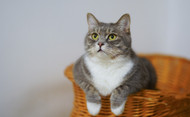3 Ways to Help a Cat Lose Weight | Alaska Mill & Feed
Posted by Kimberly McCourtney on Dec 3rd 2020
It is estimated that as many as 48% of domestic cats are overweight: Case, Linda. The Cat: Its Behavior, Nutrition & Health. Ames, IA: Iowa State Press, 2003
Helping a cat lose weight is the most important thing to do to ensure a cat’s long-term health and well-being.
1. CONTROL CALORIES AND FAT
Feed cats highly digestible, meat-based foods. Cats are obligate carnivores, which means they are uniquely adapted to get nutrients in forms only found in meat. A highly digestible food with meat as the main protein source can help prevent weight gain.
Increase the proportion of canned and raw foods in the cat’s daily diet. Feeding only canned or raw foods has been shown to help cats lose weight.* A ratio of 50% wet food to 50% dry also works well, but as little as 25% wet food can be beneficial for weight loss.
Feed a dry food properly formulated for weight loss. These foods contain adequate levels of nutrients while limiting calories and fat.
Measure food and feed smaller, more frequent meals. Consider the feeding guidelines on the bag of food to calculate how much the cat needs each day. Use a measuring cup to avoid over-feeding. Divide the amount of food into smaller meals, and feed three to six times a day.
Reduce weight slowly. Weight loss should occur at a rate of no more than 1-2% of the cat’s total body weight per week to reduce the risk of hepatic lipidosis, or fatty liver disease. This is caused when fat tissue accumulates in the liver. It can usually be reversed when detected early.
*Piobot, Biourge, Elliot, Encyclopedia of Feline Clinical Nutrition, Royal Canin, 2008.
2. PLAY MORE, TREAT LESS
The study, “Human-Animal Relationship of Owners of Normal and Overweight Cats” showed that owners of healthy weight cats played with their cats more often than owners of overweight cats.* Introducing new toys and games into the cat’s daily routine can decrease boredom, reduce tension in multi-cat households, improve coordination and help cats bond with their human family.
Find out if the cat prefers mouse-, bird-, or bug-shaped toys. Cats play with toys that look like prey, and many cats have favorite toy “species.”
Discover the cat’s favorite color. If a cat doesn’t appear interested in playing, try toys of different colors. Cats can easily see blue, green and yellow and might respond better to these colors.
Try catnip or honeysuckle to perk up a cat’s interest in a toy. Catnip and honeysuckle contain aromatic compounds that between 50% and 80% of cats seem to enjoy.

